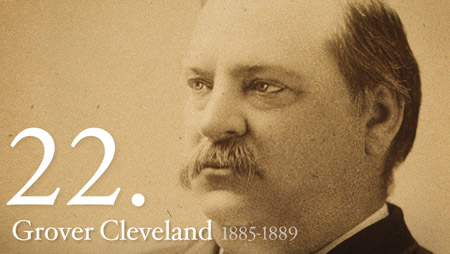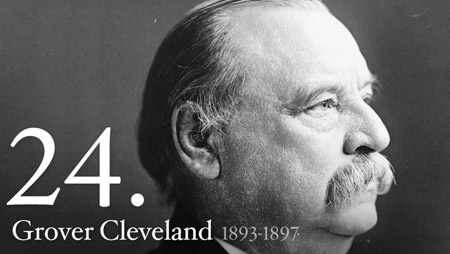
Grover Cleveland, the 22nd and 24th President of the United States, is unique in American history as the only president to serve two non-consecutive terms. His presidencies, from 1885 to 1889 and 1893 to 1897, were marked by his commitment to reform, economic challenges, and political controversies. This article provides a detailed timeline of Cleveland’s two terms in office, highlighting key dates and events that defined his presidency.
First Term: 1885-1889
Inauguration and Early Actions: March 1885
- March 4, 1885: Grover Cleveland is inaugurated as the 22nd President of the United States. Cleveland, a Democrat, succeeds Chester A. Arthur, a Republican. His inaugural address emphasizes his commitment to reforming government practices, reducing corruption, and upholding democratic principles.
- March 6, 1885: Cleveland begins his presidency by implementing a series of executive orders aimed at reducing political patronage and promoting civil service reform. He upholds his campaign promise to clean up government practices.
Civil Service Reform and Domestic Policies: 1885-1887
- June 1885: Cleveland vetoes a bill for a private pension to Union Army veterans, arguing that it sets a dangerous precedent for private pensions. This decision reflects his commitment to limited government and fiscal responsibility.
- September 1885: Cleveland implements several key reforms in the executive branch, including the dismissal of numerous federal employees to replace them with individuals based on merit rather than political connections.
- 1886: Cleveland’s administration faces challenges related to economic policies and labor unrest. He supports a gold standard policy and maintains a stance against inflationary measures, which aligns with his commitment to fiscal conservatism.
- August 1886: The Haymarket Affair in Chicago, a significant labor strike, leads to violence and public unrest. Cleveland’s administration responds by upholding law and order, demonstrating his approach to managing labor disputes and maintaining public safety.
Foreign Policy and Diplomacy: 1885-1888
- 1886: Cleveland’s administration is involved in negotiations with Great Britain over the disputed boundary between Venezuela and British Guiana. Cleveland supports the Monroe Doctrine and asserts U.S. interests in the region, leading to increased tensions with Britain.
- December 1887: The United States and Britain agree to arbitration over the Venezuelan boundary dispute. Cleveland’s firm stance and diplomatic efforts help resolve the conflict and reinforce U.S. influence in Latin America.
End of Term and Election: 1888-1889
- November 1888: Cleveland faces a challenging re-election campaign. Despite his efforts to promote reform and economic stability, he is defeated by Benjamin Harrison, the Republican candidate. Cleveland’s loss is attributed to economic issues and a contentious campaign.
- March 4, 1889: Cleveland’s first term ends as Benjamin Harrison is inaugurated as the 23rd President of the United States. Cleveland leaves office with a reputation for reform and fiscal conservatism, having faced significant political and economic challenges.

Second Term: 1893-1897
Return to Office and Early Challenges: March 1893
- March 4, 1893: Grover Cleveland is inaugurated for his second term as the 24th President of the United States. His return to office comes amid a period of economic instability and political division.
- March 1893: Cleveland faces the Panic of 1893, a severe economic depression caused by a collapse in the banking system and falling stock prices. The crisis leads to widespread unemployment and financial turmoil.
Economic and Financial Reforms: 1893-1894
- July 1893: Cleveland addresses the economic crisis by advocating for the repeal of the Sherman Silver Purchase Act, which he believes exacerbates the financial instability. His decision reflects his commitment to maintaining the gold standard and stabilizing the economy.
- August 1893: Cleveland’s administration works to restore confidence in the U.S. financial system by securing a loan from J.P. Morgan to bolster the federal treasury. This move is controversial but deemed necessary to address the immediate financial crisis.
- 1894: Cleveland faces significant labor unrest during the Pullman Strike, a nationwide railroad strike protesting wage cuts and poor working conditions. The administration intervenes by sending federal troops to break the strike, leading to violent clashes and criticism from labor advocates.
Foreign Policy and International Relations: 1893-1896
- 1893: Cleveland’s administration is involved in a diplomatic dispute with Hawaii following the overthrow of Queen Liliʻuokalani. Cleveland opposes the annexation of Hawaii and seeks to restore the queen, reflecting his commitment to anti-imperialist principles.
- 1894: Cleveland supports the Venezuelan boundary dispute arbitration, reinforcing U.S. influence in Latin America. His administration continues to assert the Monroe Doctrine and manage diplomatic relations with Britain.
End of Term and Legacy: 1896-1897
- November 1896: Cleveland’s second term comes to an end as William McKinley is elected as the 25th President of the United States. Cleveland’s presidency concludes amid ongoing economic challenges and political debates.
- March 4, 1897: Grover Cleveland’s second term ends with McKinley’s inauguration. Cleveland departs office with a mixed legacy, having faced significant economic and political challenges while pursuing his reform agenda.
Post-Presidency and Legacy
- 1897-1908: After leaving the presidency, Cleveland retires to his home in Princeton, New Jersey. He remains active in various public and private endeavors, including writing and supporting causes related to education and reform.
- 1908: Grover Cleveland dies at the age of 71. His death marks the end of a distinguished career that included two non-consecutive terms as president, a unique achievement in American history.
Legacy and Impact
Grover Cleveland’s two presidential terms are characterized by several key achievements and challenges:
- Civil Service Reform: Cleveland’s commitment to civil service reform during both terms reflects his dedication to reducing political corruption and improving government efficiency.
- Economic Policies: Cleveland’s handling of economic crises, including the Panic of 1893, demonstrates his commitment to fiscal conservatism and the gold standard. His administration’s actions in response to economic challenges have a lasting impact on U.S. financial policies.
- Foreign Policy: Cleveland’s foreign policy decisions, including his stance on the Venezuelan boundary dispute and the annexation of Hawaii, reflect his principles of maintaining U.S. influence and avoiding imperialist practices.
- Political Controversies: Cleveland’s presidencies are marked by political controversies, including his handling of labor unrest and economic instability. Despite facing criticism, his legacy as a reformer and leader remains significant in American history.
Conclusion
Grover Cleveland’s unique position as the only U.S. president to serve two non-consecutive terms highlights his impact on American politics and governance. His efforts to reform government practices, manage economic crises, and navigate complex foreign relations demonstrate his commitment to addressing the challenges of his time. Cleveland’s legacy as a leader who pursued reform and faced significant political and economic issues continues to be remembered as an important part of U.S. history.